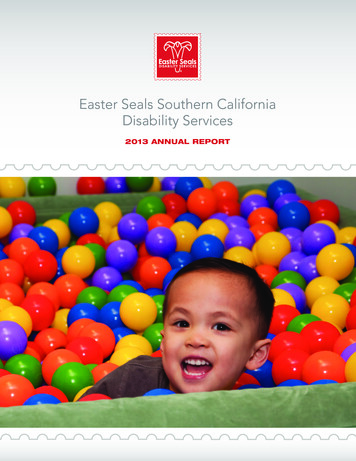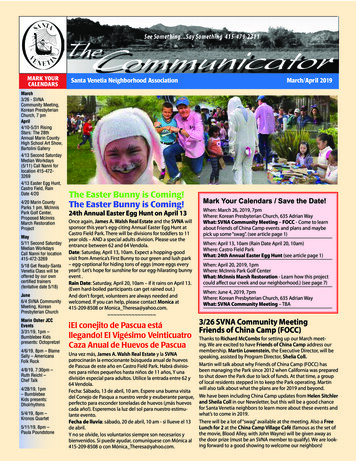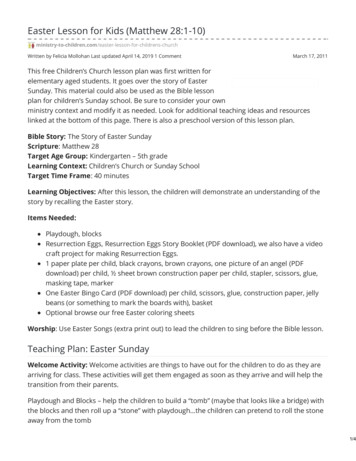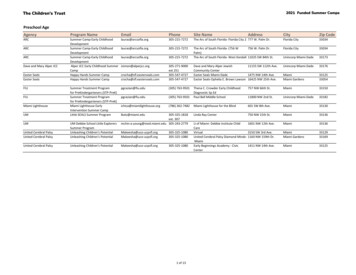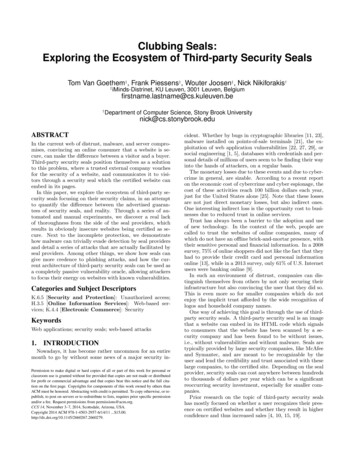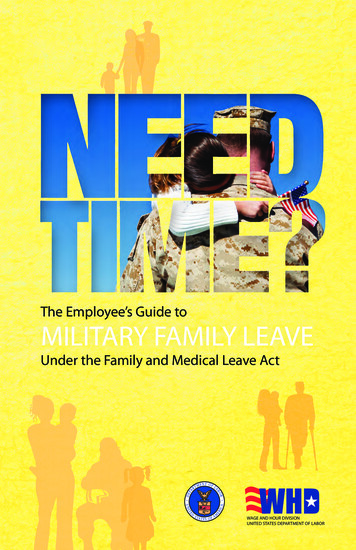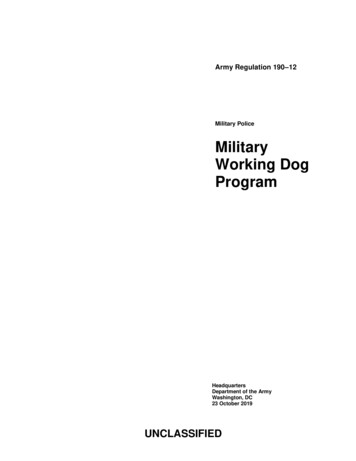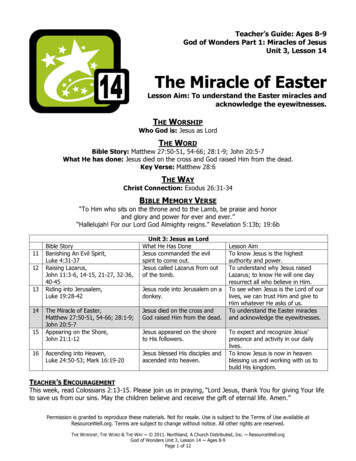
Transcription
Easter Seals Military and Veterans Services & Easter Seals Dixon Center1425 K Street, NW, Suite 200Washington, DC 20005Written Testimony of:David W. Sutherland, Colonel, U.S. Army, RetiredChairman and Co-Founder, Easter Seals Dixon CenterBefore theSubcommittee on Economic OpportunityCommittee on Veterans’ AffairsUnited States House of RepresentativesOn“A Review of the Transition Assistance Program”January 27, 2015
2Chairman Wenstrup, Ranking Member Takano and Members of the Subcommittee, thank you forinviting me to discuss the transition and reintegration needs of America’s service members and thepublic-private community partnerships needed to help make a soldier’s transition to civilian lifeseamless and, ultimately, successful.My name is David Sutherland. I am representing Easter Seals Dixon Center as an independentcontractor. I serve as the Chairman of Easter Seals Dixon Center, a catalyst for forging communitypartnerships and harnessing local supports to assist veterans and their families to succeed wherethey live. Easter Seals is a leading non-profit organization that provides local services and supportsto empower veterans, people with disabilities and others to reach their potential. Annually, EasterSeals provides direct services to about 165,000 veterans and military families. I co-founded EasterSeals Dixon Center in 2012 to leverage Easter Seals’ nationwide network of community-basedprogram locations and to work with private and public sector leaders across the U.S to create betterways for our veterans and military families to succeed in meaningful employment, education andoverall wellness. During that time, Easter Seals Dixon Center has impacted the quality of life ofnearly one million veterans and military families.Before my work with Easter Seals Dixon Center, I had the privilege of serving in the United StatesArmy for nearly three decades, including several combat tours in Desert Shield/Desert Storm andas a Brigade Commander during surge operations in Iraq during Operation Iraqi Freedom. My finalassignment was as direct report and Special Assistant to the Chairman of the Joint Chiefs of Staff(JCS) from January 2010 through June 2012, where I focused on Warrior and Family Support andco-authored a white paper, The Sea of Goodwill: Matching Donors to Needs. In The Sea ofGoodwill, my co-author, Major John Copeland, and I described a reintegration trinity of education,employment and access to health care which serves to improve the quality of life for returningservice members and their families.Through my JCS work with Admiral Michael Mullen and General Martin Dempsey and now asChairman of Easter Seals Dixon Center, I regularly meet with service members (as they prepare totransition into communities), veterans and their families as well as with leaders of government,business and the social services network from the very communities these separating servicemembers and their families will return to and call home. My team and I have also visited andworked with nearly 600 communities in the past five years to assist efforts to build publicawareness, encourage community involvement, and promote community services. Our work withprivate, public and social organizations have been the inspiration for programs such as theAdministration’s Joining Forces initiative, JP Morgan Chase 100,000 jobs initiative, Robin HoodFoundation’s Veterans Initiative in New York City, Rally Point 6 outside the gates of Joint BaseLewis McCord in Washington state, and thousands of other supportive efforts. This experienceand these coordinated efforts confirm my belief that the solution to the successful transitionof service members lies in America’s communities. I found that what typically separates atransition success story from a transition story of struggle and crisis lies in how a communitywelcomes, connects with, and responds to service members leaving the military. We don’t needmore organizations but rather we need to harness existing community-based programs and getorganizations from across society to be inclusive of those touched by military service – to use ourleadership, locally, to bring these organizations together to achieve collective impact.The federal government has a vital responsibility to ensure transitioning service members areprepared for their next, post-military step. Recent efforts to expand and improve the Transition
3Assistance Program (TAP) are critically important. However, completion of TAP should beviewed as the beginning, not the end of the federal government’s involvement in the reintegrationprocess. The hardest work begins once the service members leave their final TAP session and afterthey have received the commander’s Capstone blessing. The minute they step off the militarybase, they are in community. That is where the community transition starts. My testimony willhighlight innovative community solutions that promote successful reintegration and will shareways the federal government – through congressional action and influence – can further supporteffective public-private partnerships to increase access to education, employment and health carefor transitioning service members, veterans and their families. As an independent contractor, Ihave been authorized by Easter Seals, Inc. to present this testimony on behalf of their Military andVeterans Services.REDESIGNED TRANSTION ASSISTANCE PROGRAM A HEALTHY START:The federal government’s primary tool in helping service members transition into civilian life isthe Transition Assistance Program. I commend Congress and the Administration for its recentsteps to improve TAP, both in making it mandatory through the Veterans Opportunity to Work(VOW) to Hire Heroes Act and in redesigning TAP to include optional, tailored tracks focused oneducation, entrepreneurship and technical training. The updated TAP program is an improvementover the previous version. The sessions on translating military skills to civilian occupations (MOCCrosswalk) and on developing a budget and a plan for retirement (Personal Financial Planning) areessential components. The addition of specific next-step tracks that offer tailored instruction basedon whether the individual plans to pursue a college education, seek an industry-recognizedcredential or start a business is also very valuable. Easter Seals would support proposals aimed atproviding service members with greater flexibility and relevant tools they will need for a smoothand successful transition.My own transition experience came before many of the TAP improvements were implemented. Iattended TAP sessions at Fort Belvoir in Virginia, not far from where we are today. I will neverforget the experience – not because of the valuable information I received but rather for who I waspaired with during my transition training. In the chair to my left was a young corporal. To myright, an Army staff sergeant. We were all about to enter the civilian world after serving inuniform. But that was where our similarities ended. I was a 29 year Army veteran with a Master’sdegree who had commanded at all levels, from platoon to brigade combat team. The youngcorporal enlisted fresh out of high school and also honorably served our nation. On this day, wereceived the same curriculum, the same benefits briefing and the same employment advice, despiteour vastly different military experiences, educational backgrounds and the fact we were positionedto join the civilian labor force at different entry points. We did not benefit from the more focused,tailored training options that are now available under TAP.MORE FOCUS NEEDED ON DESTINATION AND OUTCOMES:I met a young Marine Lance Corporal named Gary who participated in the redesigned transitionprogram. Gary attended TAP courses over a two-week period, including in-depth training onemployment and the career technical training track. “Overall, the information was good. I’d rate ita B-minus or C-plus,” Gary told me. “It’d earn a higher grade had it been more specific to where Iwas going – even just sending me off with a list of key resources, such as the location of the VA orthe job service.” The Kentucky native and his wife decided to put down roots in Cincinnati, which
4was only an hour north of the small town he was raised. However, Gary’s transition training –which he received in North Carolina – lacked any specific information or guidance on thedestination of his transition to civilian life, other than an exercise where he had to identify threeopen jobs in Cincinnati from which he then developed a tailored resume and participated in a mockinterview. The redesigned transition program Gary went through is known as Transition GPS. The“GPS” in the name stands for goals, plans and success. In the civilian world, the acronym standsfor global positioning system. Nearly every driver owns a vehicle GPS device to help them findtheir destination. That’s really the point of a car GPS: to help you get to where you are going. Yetin Gary’s Transition GPS training, his destination was merely a footnote. Gary was equipped withbasic tools, but there was never instruction, strategies or next steps for connecting to thecommunity he would soon call home. More needs to be done to localize the TAP training fortransitioning service members. In addition, TAP could be improved if the program measuredoutcomes instead of simply completion. A focus on TAP outcomes was part of U.S. Houselegislation that would later become the VOW to Hire Heroes Act. Veterans’ Affairs CommitteeChairman Jeff Miller’s Veterans Opportunity to Work Act1 (H.R. 2433 – 112th Congress) includeda section on “Transition Assistance Program Outcomes” that required the Secretaries of Labor andDefense to develop a method to measure TAP outcomes, including length of unemployment of aseparated service member, beginning salary of first civilian job, and length of time enrolled incollege or training following military separation. The provision focused on participation as well asthe next-step outcomes. As best I can tell, this provision did not make it into the final VOW to HireHeroes Act (P.L. 112-56) that was eventually approved by Congress and signed into law onNovember 21, 2011.Easter Seals Dixon Center Recommendation: Congress should adopt outcome measuresfor the Transition Assistance Program to ensure that the information and tools servicemembers receive during TAP are effective, including a post-TAP follow-up to trackwhether the service member is employed, is starting a business or is receiving educationand training. In addition, TAP should be expanded to offer exiting service members theoption of attending a post-service community connection session in the actual communitythey now reside to introduce them to the resources, services and supports in thatcommunity (to address the lack of community information identified by Gary’s experience).The optional community connection classes could be organized in collaboration withcommunity and veterans service organizations or other government agencies.FACILIATING CONNECTIONS TO THE COMMUNITY FOR REINTGRATION:Under current TAP standards, Gary – the young Marine whom I mentioned earlier – would havebeen recorded as a transition success. He attended TAP and demonstrated he met career readinessstandards. He developed an integrated 12 month post-separation budget, identified his desiredemployment field and the training (commercial driver’s license) he would need to secure his idealjob, and completed a professional resume and references. Gary was self-motivated and anxious tostart his new life in Ohio with his wife and son. He and his wife had their own family transitionplan and saved for the expenses of moving their belongings from North Carolina to Cincinnati.Part of their plan was to use his final military check (due on October 1, 2013) to cover transitionbills, including the first month’s rent and deposit for an apartment he lined up for his family whilestill in North Carolina. The paycheck would also include a lump sum payment for his unused paid1Veterans Opportunity to Work Act of 2011, H.R. 2433, 112th Congress, 33:
5leave and was more than enough to cover these initial expenses. Once Gary was settled, he had aplan and the personal motivation to aggressively pursue full-time employment.Unfortunately, Gary’s smooth transition derailed while en route to Cincinnati. Gary and his familypulled up to the apartment in their moving truck only to learn his check bounced. His automaticdeposit didn’t go through and so they couldn’t move in and unload their belongings as they hadplanned. Gary learned later that the hiccup was a result of a processing delay due to the 2013federal government shutdown. The matter would eventually get resolved but not before the depositdelay left he and his family homeless, broke and in crisis. They couldn’t afford to keep the rentaltruck and so they unloaded their belongings in cheaper storage outside of Cincinnati. For the nexttwo weeks Gary, his wife and son resorted to sofa surfing from one friend and family member toanother, often having to sleep in separate locations due to space limitations. The transient andremote nature of their temporary living arrangements complicated Gary’s job hunt.Marines are known for their honor, courage and determination. And so asking for help andadmitting struggle were especially hard for Gary. But with no options and a strong desire to get hislife back on track, Gary made a call a call to his community. “I’ll never forget it,” Gary said. “Itwas 2:30 in the morning. I was on a friend’s sofa, wide-awake, when I made the call.” He calledUnited Way’s 211 and asked for help. Less than six hours after placing his call, Gary received afollow up phone call from a specialist from Operation Vets THRIVE, an Easter Seals TriStateprogram I helped to form that connects Cincinnati area veterans with local services and supports tohelp during their transition. The Easter Seals specialist learned of Gary’s financial situation andquickly connected him to three community organizations that provided immediate assistance forthe first month’s rent, the initial security deposit and other pressing needs. He was then introducedto an Easter Seals Operation Vet THRIVE employment developer who had an immediate lead for atemporary work assignment in his chosen field: transportation. Gary jumped in his car and drove tothe company, where he filled out a job application. Within the week, Gary was hired and working40 hours a week. He slowly built up his resources and confidence. Easter Seals and the Cincinnaticommunity rallied to assist Gary and his family to turn their situation around in a positive anddramatic way. Gary sent me an update last week with the news that he completed accreditedtraining, secured his commercial driver’s license and is working full time as an over-the-road truckdriver. Gary is firmly on the path toward greatness thanks to a little community support during histransition. Gary and his generation of veterans are wired to serve and represent the best of oursociety. They have accepted the call to duty and have honorably served our nation against defyingodds and enormous challenges. Easter Seals Dixon Center believes our transitioning servicemembers, veterans and their families can thrive where they live and that communities play a keyrole in the reintegration.I was drawn to the work of Easter Seals for its national scope and its long-standing commitment toserving veterans and military families. Easter Seals began serving veterans following World War IIto address gaps in service to veterans returning home with service-connected disabilities. Today,our nation’s veterans face similar challenges and once again Easter Seals is there, this time bymobilizing its national network of 73 affiliates and 550 community-based service sites throughemployment, caregiving, and transition services. Easter Seals was selected by the U.S. Departmentof Veterans Affairs (VA) to train family caregivers of seriously injured Post-9/11 veterans througha program authorized by Congress. Since 2011, Easter Seals has trained more than 26,500 familycaregivers across the country and we continue to expand our impact in this area throughpartnerships with the Elizabeth Dole Foundation, USO and others. Easter Seals also specializes in
6helping veterans, homeless veterans, and military spouses develop new work skills and find jobs intheir communities through existing programs and new efforts I’ve helped grow in Ohio, Indiana,New York, Minnesota, the District of Columbia, Virginia and California. And Easter Seals hasdeveloped and expanded its Veterans Count philanthropic effort to raise local private dollars toprovide critical and timely financial assistance to veterans, service members and their familieswhen no government or other resources are available throughout New England. Veterans Countstarted as an idea by an Easter Seals volunteer in New Hampshire who had served in the militaryand wanted a way to help service members and veterans who were struggling and just needed alittle assistance during transition. Easter Seals Veterans Count now operates in multiplecommunities across two states.Easter Seals Dixon Center is helping to further Easter Seals’ efforts by working in communities tobuild partnerships and share innovative approaches to assist those who have served. Simply put,we believe we are stronger by working with other like-minded organizations. The sea of goodwillexists across the country with groups like Easter Seals Dixon Center who are willing to worktogether for the greater good within their local communities. We saw it in Cincinnati in itsresponse to the needs of one young Marine and we are seeing it in towns and cities across theUnited States.COMMUNITY COLLABORATION CREATES EFFECTIVE TRANSITION MODELS:Operation Vet THRIVE in Cincinnati was developed with the support of community foundationsthat recognized the tremendous needs of America’s service members and veterans. One of the firstaction steps we took in launching Operation Vets THRIVE was to host a series of communityconvening meetings to mobilize the community in support of veterans by identifying existingsocial programs and gaps in services. This year-long community asset mapping process broughttogether more than 60 agencies and 200 individuals who regularly communicated and collaboratedto identify opportunities and needs around employment, education, health, housing, and familysupport. In May 2014, the community work group released an extensive community report thatincluded, among other things, a resource inventory and recommendations for continued and moreeffective collaborations. We were pleased that Chairman Wenstrup shared his personal transitionexperience in the introduction of this community report. As you may recall, when Gary made hiscall in the middle of the night, he did not call Easter Seals directly. He called United Way, one ofthe collaborators in this community process. Recognizing Gary’s needs, United Way made a warmhandoff to Easter Seals TriState, which also connected to other community organizations,including Goodwill, The Thank You Foundation and USA Cares, for the emergency financialassistance. The veteran made a single call but behind the scenes that veteran was connected to theorganizations and programs in that community that best matched his needs. This is the no-wrongdoor approach to veteran services that we are facilitating through Easter Seals Dixon Center.Over the past four years, the leadership of Easter Seals Dixon Center has worked with more than560 communities, over 20,000 organizations and thousands of like-minded individuals. Weunderstand the grassroots, community-based solutions that work, and those that do not. Wecompleted comprehensive community asset mapping processes in Indianapolis, Indiana and St.Cloud, Minnesota as a result of support through Newman’s Own Foundation, the foundationcreated by the late actor, Paul Newman. These collaborations are already leading to new and moreeffective reintegration services for veterans and transitioning service members, including a recent
7federal grant award to Easter Seals Crossroads in Indianapolis to help address the employment andsupport needs of unemployed veterans who are homeless or at-risk of homelessness.Like in the case of Gary, the community became the final catchall after all other systems andprograms missed. Unfortunately, there is no mechanism for the social service network and othercommunity organizations to actively engage in support of these service members. While we arecreating warm handoffs in the private sector, there is no warm handoff between TAP and thecommunity. There needs to be a more effective way of connecting the separating service memberto the community he or she is planning to go – either prior to or during their transition. TheDepartment of Defense, for example, is not designed to provide these follow-along communitysupports, but some type of handoff within the community to the state director of veteran services,American Job Center staff or local veteran service organizations could help promote smoothertransitions. This handoff could be an optional follow-along for service members who sign apersonal information disclosure form stating they want to disclose their information to thecommunity they are transitioning into for additional community-based assistance during theirtransition. This disclosure form could also be the mechanism to help implement my earlierrecommendation of an optional community connection TAP session held in the community wherethe recently transitioned service member lives.Easter Seals Dixon Center Recommendation: Congress should authorize and allocatefunding to the U.S. Department of Veterans Affairs to support communities in assetmapping and community collaboration around veteran services and programs to ensurethat however a veteran connects to the community their call for assistance is answered andeffectively addressed locally. In addition, Congress should push for changes to TAP to giveservice members the options of sharing their contact information to the community they aretransitioning into to promote greater transition success.VETERAN REINTEGRATION NEEDS BEYOND TRANSITION:While this hearing is focused on the immediate transition needs of separating service members Iwant to raise a growing gap in services that exists for veterans who are experiencing seriousreintegration challenges long after their combat missions and separations from the military. Whilethe federal government and communities can and must do more to assist those who have recentlytransitioned or are scheduled to exit the military, we must also recognize that reintegrationchallenges often surface months or years after the initial transition. Communities need to be thereto support these veterans and their families before their situations turn crisis and require moreintensive and expensive interventions. VA Secretary Robert McDonald described at the NationalPress Club2 that the peak demand for VA services from a veteran who served in a war occurs 40years from the end of the war. However, early intervention and regular access to community-basedservices throughout the lifetime of a veteran can help minimize or alleviate this peak demand.Easter Seals works regularly with veterans where challenges surface years after they served ournation. Their initial transition was smooth and seamless but issues rise later on – often when theyfeel under siege on the home front due to a broken relationship, lost job or other stress. Theseveterans rely on and often turn to their communities for assistance to help them thrive again. Somecommunities are prepared to embrace them and connect them to the services and supports they2U.S. Department of Veterans Affairs Secretary Robert McDonald, National Press Club speech, mcdonald
8need to succeed. Others remain unprepared or lack resources to intervene in an effective way. Thefederal government should support these communities by expanding and funding care coordinationmodels that can effectively connect with and meet the needs of veterans and their families beforetheir situations turn crisis, including direct referrals to the VA or other community services.Congress has done an effective job in developing and funding programs to assist veterans throughcommunity-based services and supports when they have hit crisis. For example, the SupportiveServices for Veterans Families (SSVF) at the Department of Veterans Affairs provides grants tocommunity organizations to provide care coordination and supportive services to veteran familieswho are homeless or at-risk for homeless. The Homeless Veterans’ Reintegration Program(HVRP) at the U.S. Department of Labor provides grants to community organizations to provideemployment supports and supportive services to unemployed veterans who are homeless or at-riskof homelessness. Both programs are effective because of the public-private care coordinationmodel that recognizes the myriad reasons a veteran can become homeless, from poverty and lackof support from family or friends to substance use or mental health challenges.However, both of these programs target veterans when they have hit a crisis situation and whenthey are the hardest-to-serve. All veterans that seek help in their communities should have accessto early intervention and supportive services through a SSVF/HVRP-like community model.Easter Seals welcomes the VA’s implementation of the Section 506 pilot program authorizedthrough Public Law 111–163 to increase the coordination of services and benefits to assist veteranswho are transitioning from military service to civilian life. Congress authorized four types oflocations in the P.L. 111-163 pilot: rural areas, areas with populations that have a high proportionof minority group representation, areas with populations that have a high proportion of individualswho have limited access to health care, and areas that are not in close proximity to an active dutymilitary installation. The two-year pilot (which the VA has implemented as the Rural VeteransCoordination Pilot) is further recognition that reintegration success lies in communities and thatthe federal government has a responsibility to help those communities effectively respond to theneeds of their residents who are veterans.Easter Seals Dixon Center Recommendation: Congress should expand community-basedcare management and supportive services models to address the unmet needs of veteranfamilies. Congress could take immediate steps by extending the time-limited Section 506pilot program (P.L. 111-163) and by expanding the pilot to all authorized communitylocations, including the use of multi-service site grants to test service delivery efficiencies.CONCLUSION:My military service over two wars informs me about the difficult challenges facing America’stransitioning service members and veterans and motivates me to help empower them to achievetheir capacity for greatness. Effectively addressing the reintegration needs of transitioning servicemembers and veterans will require attention, energy and resources. But every veteran matters.Communities are trying to respond but they need additional support from Congress to promotepublic-private partnerships and to increase access to community-based services and supports. As Idiscussed, Congress can start by: Establishing outcome measurements and increasing community connection within TAP,including an optional community-connection follow along session;
9 Authorizing and funding asset mapping grants to communities and communityorganizations; andExtending and expanding programs such as the Rural Veterans Coordination Pilot (P.L.111-163 Section 506 pilot) to address ongoing reintegration needs through communitybased care coordination and supportive services.Thank you for your leadership and for all you have done to help improve the transition andreintegration of America’s service members and veterans. This is important work, but the rewardof our hard work is in the altered lives of veterans like Gary. Their lives are better because of ourcollective efforts and attention. Their successes are what motivate us to continue our expansion ofpublic-private partnerships to make sure all veterans and transitioning service members get theassistance they need during transition to thrive and grow in their communities. Thank you again. Iam pleased to take your questions.
10David W. Sutherland, U.S. Army, RetiredCo-Founder and Chairman, Easter Seals Dixon CenterFounder and President, Sutherland PartnershipColonel David W. Sutherland is the co-founder and Chairman of Easter Seals Dixon Center andactively contributes to numerous national veteran and military family committees and boards.Sutherland speaks in communities at universities, businesses and conferences around the countryas a vocal advocate and leader for transformational change. He is a vocal advocate for our servicemembers, military veterans, their families, and the families of our fallen.Colonel Sutherland culminated his 29 years of service following Brigade Command, as the SpecialAssistant to the Chairman of the Joint Chiefs of Staff with principle focus on Warrior and FamilySupport. By visiting hundreds of communities and assisting thousands of organizations, he createda nationwide network of support utilizing grassroots solutions for veterans and their families.Awards and decorations include, among others, the Bronze Star Medal with oak leaf cluster,Purple Heart, Ranger Tab, Combat Infantryman's Badge Second Award and Senior ParachutistBadge. He is also the 2008 Freedom Award recipient presented by the No Greater SacrificeFoundation and the 2011 Meritorious Service Award recip
Chairman Wenstrup, Ranking Member Takano and Members of the Subcommittee, thank you for inviting me to discuss the transition and reintegration needs of America's service members and the public-private community partnerships needed to help make a soldier's transition to civilian life seamless and, ultimately, successful.


